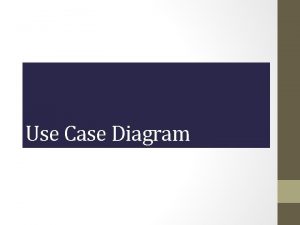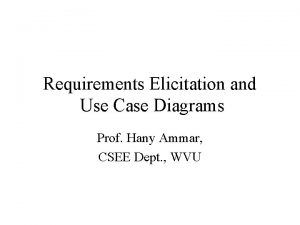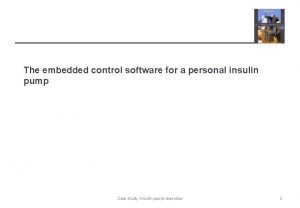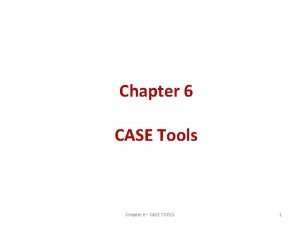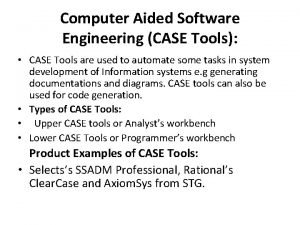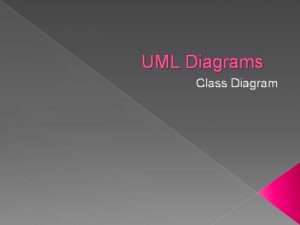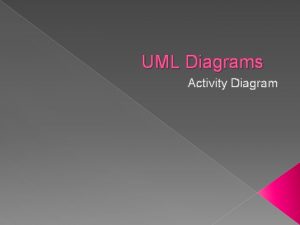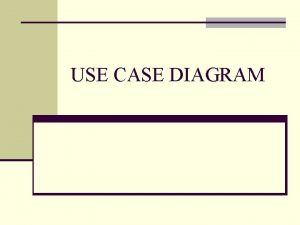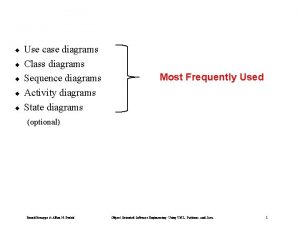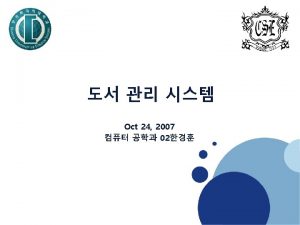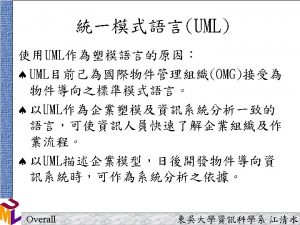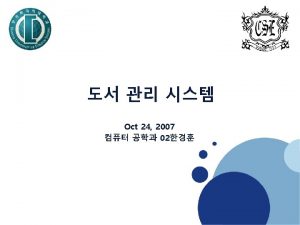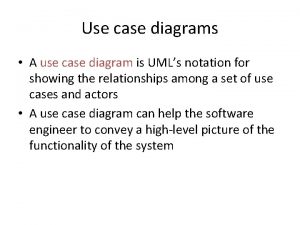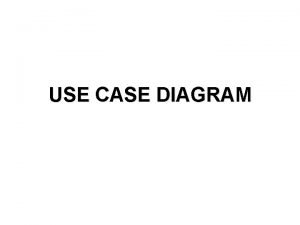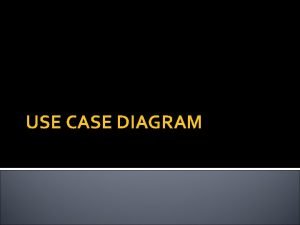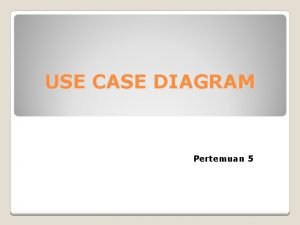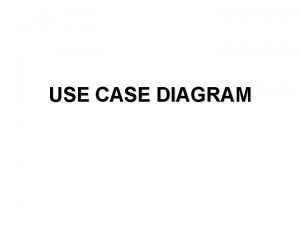Software Engineering USE CASE DIAGRAM Use case diagrams


















- Slides: 18

Software Engineering USE CASE DIAGRAM

Use case diagrams In UML, use case diagrams model the behavior of a system and help to capture the requirements of the system. Use case diagrams describe the high-level functions and scope of a system. These diagrams also identify the interactions between the system and its actors. The use cases and actors in use case diagrams describe what the system does and how the actors use it, but not how the system operates internally.

Use case diagrams are helpful in the following situations: v. Before starting a project, you can create use case diagrams to model a business so that all participants in the project share an understanding of the workers, customers, and activities of the business. v. While gathering requirements, you can create use case diagrams to capture the system requirements and to present to others what the system should do. v. During the analysis and design phases, you can use the use cases and actors from your use case diagrams to identify the classes that the system requires. v. During the testing phase, you can use case diagrams to identify tests for the system.

Use Case Modeling: Core Elements

Use Case Modeling: Core Relationships <<extend>>

Extend dependency Example Base use case << extend>> Extend use case Purchase Book with credit card << extend>> Print receipt Another kind of relationship between use case is called extend dependency, and extend dependency indicates optional relationship between use case. Extended use case expand the behavior of base use case, u have an option to extend the behavior of base use case any some point. Extend use case depend on the base use case, also, the extending use case expand behavior of the base use case by addition new sequence of steps to the steps that are already exist to the base use case.

Generalization Examples

Use Case Modeling: Core Relationships (cont’d) <<include>>

Invoking use case << include >> Make a purchase Withdraw cash Verify credit card << include >> Verify balance << include >> Transfer Cash < Included use case c < in l > e d u > include dependency Shows necessary relationship between two use cases, the invoking use case depend on included use case in order to complete. include use case usually drawn on the right side of the invoking use case just a convention.

Example 1: Automatic Teller Machine (ATM) Actor: customer (primary actor) left side of diagram goals (use cases) : withdrawn cash, deposit funds, check balance, transfer funds who else interact. . some one perform maintenance actor -- Maintenance (initiator) goal (use cases) -- perform routine maintenance Actor -- Stocker (initiator ) goal (use cases) : Fill ATM with cash Secondary actor (mostly right side of the diagram) Bank <<System>> to answer the goals. . .

UML Use Case Diagram Example

UML Use Case Diagram Example

UML Use Case Diagram Example Hospital Management System is a large system including several subsystems or modules providing variety of functions. UML use case diagram example below shows actor and use cases for a hospital's reception. Purpose: Describe major services (functionality) provided by a hospital's reception. Hospital Reception subsystem or module supports some of the many job duties of hospital receptionist. Receptionist schedules patient's appointments and admission to the hospital, collects information from patient upon patient's arrival and/or by phone. For the patient that will stay in the hospital ("inpatient") she or he should have a bed allotted in a ward. Receptionists might also receive patient's payments, record them in a database and provide receipts, file insurance claims and medical reports.


UML Use Case Diagram Example Airport Check-In and Security Screening Actors are Passenger, Tour Guide, Minor (Child), Passenger with Special Needs (e. g. with disabilities), all playing external roles in relation to airport business. use cases are Individual Check-In, Group Check-In (for groups of tourists), Security Screening, etc. - representing business functions or processes taking place in airport and serving the needs of passengers. use cases Baggage Check-in and Baggage Handling extend Check-In use cases, because passenger might have no luggage, so baggage check-in and handling are optional.



 Use case model
Use case model Use case diagram game
Use case diagram game Uml activity diagram tutorial
Uml activity diagram tutorial Use case with multiple actors
Use case with multiple actors Why are use case diagrams important
Why are use case diagrams important Object diagram captures the behavior of a single use case
Object diagram captures the behavior of a single use case Computer based system engineering in software engineering
Computer based system engineering in software engineering Forward engineering and reverse engineering
Forward engineering and reverse engineering Software maintenance process models ppt
Software maintenance process models ppt What is software implementation in software engineering
What is software implementation in software engineering Metrics computer science
Metrics computer science Software engineering crisis
Software engineering crisis Software metrics and software metrology
Software metrics and software metrology Real time software design in software engineering
Real time software design in software engineering Software design fundamentals in software engineering
Software design fundamentals in software engineering Test case in software engineering
Test case in software engineering Insulin pump case study in software engineering
Insulin pump case study in software engineering Case tools automate
Case tools automate Case tools automate
Case tools automate



